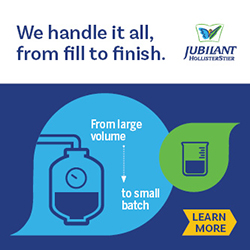Olema Oncology Announces First Clinical Data on OP-1250 in Advanced ER+/HER2- Breast Cancer
Olema Pharmaceuticals, Inc. recently announced the first clinical data from the Phase 1 dose-escalation portion of the ongoing Phase 1/2 clinical trial of OP-1250, a complete estrogen receptor (ER) antagonist (CERAN) and a selective ER degrader (SERD) in development for the treatment of metastatic breast cancer and other women’s cancers. Data as of October 1, 2021, was presented in a poster presentation at the San Antonio Breast Cancer Symposium (SABCS). Updated data as of November 1, 2021, are detailed below.
These initial data provide strong proof-of-concept for OP-1250 as a once-daily oral monotherapy in women with recurrent, locally advanced or metastatic ER+/HER2- breast cancer and demonstrate OP-1250’s potential to become a best-in-class endocrine therapy. In the trial, OP-1250 showed highly attractive pharmacokinetics supporting once-daily dosing, favorable tolerability, and clear evidence of anti-tumor activity. Three partial responses (2 confirmed, 1 unconfirmed) and robust target lesion reduction up to 100% were observed in a heavily pretreated patient population. In the recommended Phase 2 dose (RP2D) range of 60-120 mg OP-1250 once daily, the overall response rate (ORR) was 17% and the clinical benefit rate (CBR) was 46%.
“We successfully delivered on our objectives for the dose-escalation stage of our ongoing Phase 1/2 trial of OP-1250, with the desired pharmacokinetics, favorable tolerability, and early but clear efficacy signals. We are particularly encouraged by the responses observed in patients who had received multiple prior lines of therapy and harbored ESR1 activating mutations, demonstrating that OP-1250 is an active drug and achieved sufficient exposure levels to block the ER-mediated cancer cell growth and proliferation signal,” said Sean P. Bohen, MD, PhD, President and Chief Executive Officer of Olema Oncology. “These data give us confidence to rapidly advance our development program in both monotherapy and combination settings, as we work to further position OP-1250 as a differentiated, potential best-in-class CERAN that we believe could become the backbone endocrine therapy of choice for ER+ breast cancer.”
“These promising interim data suggest OP-1250 may provide meaningful benefit to patients with advanced or metastatic breast cancer, and who may have limited treatment options remaining,” added Pamela M. Klein, MD, Chief Medical Officer. “Having accomplished our intended goals with the completed Phase 1 dose escalation, we are currently enrolling patients in dose expansion at two dose levels and expect to initiate Phase 2 monotherapy and the first combination study with a CDK4/6 inhibitor in the first quarter of 2022. As we accelerate enrollment in the coming months, we look forward to gaining additional insights into OP-1250’s potentially differentiated and best-in-class profile.”
Pharmacokinetics (PK), safety, tolerability, and anti-tumor activity of once-daily OP-1250 monotherapy were evaluated in the open-label, dose-escalation portion of the ongoing Phase 1/2 clinical trial (NCT04505826). As of November 1, 2021, a total of 41 patients with recurrent, locally advanced or metastatic ER+/HER2- breast cancer were enrolled across 7 dose cohorts (30 mg, 60 mg, 90 mg, 120 mg, 150 mg, 210 mg, and 300 mg once-daily).
This was a difficult-to-treat, heavily pretreated population: 95% of patients were previously treated with a cyclin-dependent kinase (CDK) 4/6 inhibitor (9 patients, or 22%, received 2 or more prior CDK4/6 inhibitor regimens), 68% of patients received prior fulvestrant, and 42% received prior chemotherapy in the advanced setting. Overall, patients received a median of 3 prior lines of anti-cancer therapy and 2 prior lines of endocrine therapy in advanced settings. Of 39 patients whose circulating tumor DNA (ctDNA) was assessed, ESR1 mutations were detected in 49% at baseline.
PK
Pharmacokinetic analyses demonstrated dose-proportional increases in OP-1250 exposures across all evaluated doses, high oral bioavailability and steady-state plasma levels with minimal peak-to-trough variability. At doses 60 mg and above, OP-1250 achieved exposures exceeding the predicted thresholds for maximal anti-tumor efficacy based on preclinical models.
Tolerability
OP-1250 was generally well tolerated, and no dose-limiting toxicities were reported at any of the seven dose levels studied. A maximum tolerated dose was not reached. The majority of reported adverse events were grade 1 or 2 at all dose levels, and the most common treatment-related adverse events as assessed by study investigator were nausea (49%), fatigue (34%), vomiting (22%) and headache (17%). No clinically significant bradycardia, ocular toxicities or diarrhea occurred. A RP2D range of 60 to 120 mg was identified for further evaluation based on pharmacokinetics, favorable tolerability, and initial evidence of anti-tumor efficacy.
Efficacy
Three partial responses were observed among 24 efficacy-evaluable patients, including 2 confirmed partial responses and 1 unconfirmed partial response in a patient with robust target lesion reduction of 100%, but whose response remained unconfirmed due to progressive disease with a new lesion appearing at a follow-up visit. All 3 responses occurred in patients with ESR1 mutations and who had previously received CDK4/6 and aromatase inhibitors, and fulvestrant. Four response-eligible patients had target lesion reductions of greater than 30%.
Patients were considered efficacy-evaluable for ORR if they had RECIST-measurable disease at baseline and at least one post-baseline tumor assessment or discontinued treatment prior to their first post-baseline assessment, and for CBR if they were enrolled at least 24 weeks prior to the data cut-off date. Across all doses, the ORR was 8% (2/24) and the CBR was 29% (7/24). For the dose levels within the RP2D range, the ORR was 17% (2/12) and the CBR was 46% (6/13).
As of the data cut-off date, 32% of patients (13/41) remained on treatment with efficacy data continuing to mature, including both patients with confirmed partial responses.
Anticipated Milestones
Based on these promising data, Olema is rapidly advancing OP-1250’s clinical development program with a number of anticipated program milestones. Phase 1b dose expansion is ongoing at two dose levels (60 mg and 120 mg daily) and is expected to enroll 15 patients in each cohort. Findings from this stage will help inform selection of the RP2D.
Phase 2 efficacy evaluation is expected to initiate in Q1 2022 with approximately 80 patients enrolled across three cohorts: patients with measurable disease (n=50), patients with non-measurable disease (n=15), and patients with CNS metastasis (n=15). The first Phase 1b combination study with a CDK4/6 inhibitor is expected to initiate in Q1 2022, with additional combination studies with CDK4/6 and PIK3CA inhibitors planned in 2022. A pivotal study for OP-1250 in the metastatic setting is expected to initiate in 2023.
Olema Oncology is a clinical-stage biopharmaceutical company focused on the discovery, development, and commercialization of targeted therapies for women’s cancers. Olema’s lead product candidate, OP-1250, is an orally available small molecule with combined activity as both a complete estrogen receptor (ER) antagonist (CERAN) and a selective ER degrader (SERD). It is currently being evaluated as a single agent in an ongoing Phase 1/2 clinical trial in patients with recurrent, locally advanced or metastatic ER-positive (ER+), human epidermal growth factor receptor 2-negative (HER2-) breast cancer. Olema is headquartered in San Francisco and has operations in Cambridge, MA.
Total Page Views: 981














